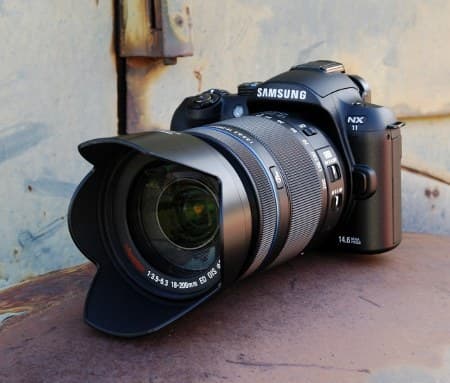Samsung NX11 first look review
Samsung NX11 review. First look

You would be forgiven for thinking that the newly released Samsung NX11 is more than a little like the company?s current NX10, but there are a few differences that are not obvious at first glance. Samsung?s information focuses on a restyled hand grip on the front of the body, and the additional functionality that can be gained when using the company?s i-Function lenses. The new grip is indeed comfortable, but I hadn?t noticed that the NX10 wasn?t, and the automatic switching to picture modes that suit the lens will probably help beginners to get better pictures more easily. For those who don?t feel the need for subject-based exposure modes, and a new dedicated position on the mode dial for it, there are a few other changes that will be of more interest.
What else is new on the Samsung NX11?
 Hyunjung Hong and Choonghyun Hwang of Samsung Korea
Hyunjung Hong and Choonghyun Hwang of Samsung Korea
According to Choonghyun Hwang, a Samsung digital imaging vice president, the new camera has an improved autofocusing system. He told me in a meeting at the Consumer Electronics Show in Las Vegas, that the NX11 now has faster AF than the NX100, which in turn is faster than the NX10. He also said that the image sensor is also slightly improved, but that the changes were made for AF speed rather than for image quality, Hwang stated that the image quality of the NX11 is the same as that of the NX10, but in fact even at first glance it is possible to see that noise reduction is much improved ? to the level that is found in high ISO images from the NX100.

Further new features include a panoramic mode that records when the camera is swept in an arc ? up and down, as well as from right to left. The camera can be held in the landscape orientation to create an image measuring about 4128×900 pixels, or in portrait orientation for make images measuring about 1440×2576 pixels. In first use the mode seems to work very well once you get a feel for the speed at which you should sweep the camera around.

What came as a complete surprise is that the Samsung NX11 has new shooting formats. As well as the usual three resolutions of 3:2-ratio image, users can choose to shoot either square or 16:9 widescreen shaped pictures. This is an excellent addition, and it brings the company?s offering into line with the Micro Four Thirds cameras of Panasonic and Olympus.
 Samsung NX11 first impressions
Samsung NX11 first impressions
Samsung NX11 first impressions

Although the camera I had to use was a pre-production sample it performed extremely well. The improvement in the AF system is clear to see and side-by-side with the NX10 the NX11 is notably faster and more certain. The metering seems set up in the same fashion as the systems in the NX10 and NX100 ? it worked reliably and constantly about 1/3EV lighter than I like. Fortunately it is very easy to access the exposure compensation function, so this will have no need to bother you.
The grip does make a tiny difference to the experience, as the physical difference is tiny in itself. I suppose it is more comfortable, but I wouldn?t be upgrading just for that.

On top of the new AF the new shooting formats make the biggest difference to me. The location in which I was testing this model leant itself to square black and white, and movie-screen-shaped faded colour, and I was able to get that right out of the camera.
So far, and I can?t draw complete conclusions just on the experience of a few hours with the camera, it seems a worthy addition to the NX family. What seemed at first as an insignificant alteration actually appears to be a bit more than that. Samsung has updated its DSLR form-factor NX body to be completely compatible with i-Function lenses, but at the same time introduced a few extras to make using the camera a much better experience.
New Samsung NX lenses
New Samsung NX lenses

For this test I was able to use the new 20-50mm f/3.5-5.6 wideangle i-Function zoom and 18-200mm f/3.5-6.3 OIS superzoom. Samsung is labelling the superzoom ?Movie Pro? as a model suitable for movie makers, as it features a very quiet AF motor. The lens is bigger and more heavy than I expected, but I suppose the AF construction is more bulky and hopefully the added weight will be reflected in the quality if the optics. From my use all I can say is that the lens is comfortable to use and does not look out of place on the NX10/11 style bodies. The focusing seems quick, but the unit I had was far from finished. This lens isn?t due out until later in the first half of this year.

On the Samsung stand a display cabinet showed the complete lens range, including the forthcoming 85mm f/1.4 portrait lens. This is another bulky lens, but we are used to the size that comes with a fast aperture in this type of focal length. It looks very impressive, but I questioned Mr Hwang about this choice of focal length in an APS-C camera. The renown for being an ideal focal length for portraiture was born in the days of 35mm film, and the rash of new versions we have seen from many manufacturers over the last year have all been designed for 24x36mm sensors. This focal length on an APS-C sensor acts more like a 135mm, while a 56mm f/1.4 would be better for emulating the famous perspective. Mr Hwang though said he thought 135mm a fine focal length for portraits ? which it is, I suppose.

The other new lenses on show were the 60mm macro f/2.8 and the 16mm f/2.4 pancake. Although the 16-80mm Movie Home f/3.5-4.5 OIS was shown on a ?road map? poster it was not on display. In previous mentions the Movie Home lens was labelled ?PZ? for power zoom, but Mr Hwang said that the company had not yet decided whether to use the power zoom function or not.
 Samsung NX11 picture gallery
Samsung NX11 picture gallery
Samsung NX11 pictures

















